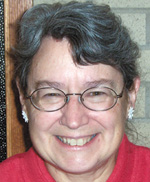By Corrine Winter

Opening the Second Vatican Council, Pope John XXIII exhorted the bishops in attendance and all members of the Church to rejoice in the opportunity for renewal afforded by the event. In his address (Gaudet Mater Ecclesia, in English, Mother Church rejoices, available on line) he carefully sounded notes of both continuity with the councils of history, in particular with Vatican I, and renewal in light of a changing world and its needs.
He asserted the intention of the Church to address errors by presenting the truth of salvation and to do so not by condemnation of errors and of their proponents, but by clear witness to the truth in accord with the signs of the times. He cited the progress of human history and even its tremendous difficulties as an instrument of Divine Providence “wisely disposing of all things (GME 9).” The Church, without abdicating its own authority, was to examine itself, its structures and its mission so that it might better serve the world.
The work of self-examination was, to indulge in understatement, not easy. In November 1962, the bishops received a schema on the Church that stressed almost exclusively the institutional structures and authority of the Church. Tellingly, the subject of the opening chapter was “the nature of the Church militant.” The document has been further described as juridical in tone, defining Church membership and ecclesial roles largely in terms of legal duties and requirements. Further, it paid little attention to the ecumenical movement that was, at the time, growing among Protestants, and offered little encouragement that the Catholic Church was called to participate in ecumenical discussions. Anyone who has read the conciliar documents on the Church and on the Church in the modern world will know by now that they are very different in structure and tone from that early draft.
The schema came to the Council floor for debate in December 1962. Bishops proposed among other things that the draft lacked reflection on the mystery of the Church and its sacramentality, on the people of God, especially on the role of the laity. Moreover, it did not present biblical or historical grounds for the self-understanding and work of the Church. They noted that Vatican I had already defined papal primacy and the infallible teaching office of the pope and that this council should address the role of bishops and their collegiality. The draft never came to a vote because the pope himself insisted that it (along with the document on Revelation) needed to be drastically revised.
The document was revised several times amid debate between proponents of a stronger hierarchical emphasis and those who wished to stress collegiality and the vital role of all members of the Church. The document that was finally approved, almost unanimously, near the end of the third session of the Council, is still not perfect. It bears clear evidence of compromises among groups with different concerns. But it represents important steps in reflection on the Church.
The document opens with reflection on the Church as mystery with multiple images shedding some light on its meaning without exhausting its richness. It stresses the Church’s mission, its call to be for the world a sacrament, a sign and instrument of the unity with and in God, the sharing in the very life of the Trinity, to which all creation is called as its proper consummation. It recognizes that the structures of the Church have evolved during its history and retrieves from the Tradition the pastoral and eucharistic emphasis regarding the role of bishops. It describes the Church as a “communion of churches” stressing the local Church (diocese). The Church is described as the “People of God” into which we are incorporated by baptism and in which each member has a vital role. Finally, Lumen Gentium expresses openness to both ecumenical and interfaith dialogue, citing a link with other Christians by baptism, faith and the Holy Spirit (LG 15); and shared values with other faith traditions.
Unlike earlier councils of the Church, Vatican II was not about defining or re-asserting particular doctrines in response to heresies; it was about renewing and re-energizing the Church for its mission in the world. Thus, the work outlined by the Council remains unfinished. Rightly, the words of the Vatican documents continue to inspire theological and pastoral debate, as well as challenging us to ongoing renewal.
(Winter is a professor of theology at St. Ambrose University in Davenport.)







